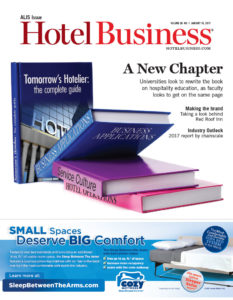Luxury hotels are expected to post another steady, solid year in 2017; however, experts are mixed on just how much further the premium-priced segment can continue to push room rates. Especially since occupancy levels, often still running at near-record highs, are forecast to only fall less than one point this year.
Overall, the luxury outlook is of a generalized slow-down in growth rates, in part due to multiple economic factors, but also simply because of our present downside stage of the lodging cycle. Luxury hotels have dominated early and often since the 2009 recession, but sources told Hotel Business that the peak recovery levels of recent years are now gradually slipping away.
“From a chainscale perspective, over the last four or five years now, who recovered first and why? It was clearly luxury,” said R. Mark Woodworth, senior managing director, head of lodging research, CBRE Hotels’ Americas Research. “The higher the price point that you competed at, the more quickly your business began to grow as we came off the bottom of the recession and moved back to more normal times. As a consequence, now that it’s been a five-year run, luxury is kind of hitting its head against the ceiling.”
CBRE Hotels’ Americas Research is expecting a minor occupancy dip of -0.7% to 74.3% overall, an ADR gain of 1.9% to $330.09 and RevPAR growth of 1.2%, to $245.38. STR, meanwhile, is projecting a somewhat more optimistic forecast for the segment, with a year-end 2017 occupancy decline of -0.5%, ADR growth of 2.8% and a RevPAR increase of 2.3%.
“Occupancy is forecast to be well into the 70s, so given seasonal travel patterns, as a practical matter they’re at their maximum occupancy,” said Woodworth.
Another contributing factor to the current outlook has been group demand, which recovered gradually after the recession, ramped up in 2015 but then turned sluggish again in 2016. How that demand sector performs in 2017 will have a significant impact on the performance of luxury.
“In 2016, group demand wasn’t good,” said Bobby Bowers, SVP of operations for STR. “Group occupancy is down, and that’s at the upper end. Corporate profits have been weak, and although the larger conventions and meetings have not dropped off as much, it’s the associations and mid-range to smaller ones that have.”
Experts also noted that 2016 being an election year—and a tenuous one at that—likely also had an impact on the sagging group demand.
“Back in 2015, we began to see some pull-back on corporate spending,” said Woodworth. “We knew that was coming because, to some degree, that happens about a year ahead of a presidential election. Companies start to conserve, they’re a little more uncertain about what the future holds, and it’s more pronounced in an election year when it’s known there’s going to be a change of president.”
In the meantime, many owners are focusing more on courting and profiting from leisure demand. Leisure guests are currently providing a steady stream of room nights, especially in resort locations, making it easier for owners to wait for group demand to normalize again now that the political-economic landscape is less uncertain.
“Guests have always craved luxury hotels, but we are seeing now, more than ever, that demand-pricing correlation is aligning with services and product,” said Michael George, CEO, Crescent Hotels & Resorts. “The luxury segment is well prepared to thrive in 2017, especially with the assistance of a pro-business government administration pumping the U.S. economy and inspiring the luxury guest to spend. Like boutique hotels, the luxury segment has become fragmented and convoluted. Luxury does not chase sexy or cool; rather, luxury will always own quality, features and services. Today, a ‘wow’ factor with digital marketing, social media and aligning with a premier brand and an operator that screams luxury, is what tilts the scales.”
It’s not hard to be optimistic when demand levels remain so high. Granted, the segment is seeing its share of new supply, but on a smaller scale than some of the more ubiquitous sectors. On a relative basis, CBRE Hotels’ Americas Research expects luxury supply to grow 3.9% in 2017, compared to demand growth of 3.1%, but researchers aren’t overly concerned about the expanded room inventory coming online in 2017.
“There is a little bit of growth in the luxury end,” said Robert Mandelbaum, director of research information services, CBRE Hotels’ Americas Research. “It’s a small segment, so one 500-room hotel is disproportionate. In terms of absolute number of projects, there’s still not a lot of luxury and/or upper-upscale compared to upscale and upper-midscale. It’s just because the development economics at the luxury level remain very challenging.”

